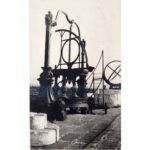Photography Balustrade in Front of the Hall of Abstinence at the Temple of Heaven
A black-and-white photograph showing the marble balustrade in front of the Hall of Fasting (Zhaigong 齋宮). It stands in the Temple of Heaven complex (Tiantan 天壇) in Beijing as the main temple on a fenced area of a few hectares in the western part of the complex. It was built in 1420 by the Yongle emperor (reigned 1402–1424). Here the emperors of the Ming and Qing dynasties performed the rites of heavenly worship twice a year. In the Hall of Fasting, the emperor performed the rites of purification and fasting before the main ritual on the day of the winter solstice, when thanks were given to heaven for the favours of the past year.
The white marble balustrade of hanbai yushi 漢白玉石 with rich reliefs is typical of the buildings used by the emperor and is also found in the Forbidden City (Gugong 故宫 or Zijincheng 紫禁城). The motif on the column finials is a dragon with five claws (wu jiao jin long 五爪金龍), symbolising the absolute power of the emperor. ... more
A black-and-white photograph showing the marble balustrade in front of the Hall of Fasting (Zhaigong 齋宮). It stands in the Temple of Heaven complex (Tiantan 天壇) in Beijing as the main temple on a fenced area of a few hectares in the western part of the complex. It was built in 1420 by the Yongle emperor (reigned 1402–1424). Here the emperors of the Ming and Qing dynasties performed the rites of heavenly worship twice a year. In the Hall of Fasting, the emperor performed the rites of purification and fasting before the main ritual on the day of the winter solstice, when thanks were given to heaven for the favours of the past year.
The white marble balustrade of hanbai yushi 漢白玉石 with rich reliefs is typical of the buildings used by the emperor and is also found in the Forbidden City (Gugong 故宫 or Zijincheng 紫禁城). The motif on the column finials is a dragon with five claws (wu jiao jin long 五爪金龍), symbolising the absolute power of the emperor. The dragons’ bodies intertwine with the clouds in inlays, and their heads protrude from the wall below the balustrade. A small stone pavilion, the Shizhaiting Pavilion 時辰亭 or “Two-Hour Pavilion” is located next to the hall. The word shizhen 時辰 refers to a traditional unit of measurement for time, namely one of the twelve two-hour intervals of the day.
The purpose of the pavilion is indicated by its widely used name, “Reporting Pavilion”. At this place, officials from the Bureau of Rituals (Libu 禮部) gave the schedule of sacrificial ceremonies to the officials who accompanied the emperor to the Hall of Fasting. They forwarded the schedule to the emperor. A bronze statue was placed in the second pavilion during the fasting and purification rites to remind the emperor to abstain during fasting.
The building behind the balustrade has five entrances to the five rooms on the eastern side where the emperor lived while fasting. It was built using the traditional Chinese construction technique, the dougong 斗拱 system, characterised by the use of timber joints or dowels, which allow structural elements to support each other during construction. This eliminates the need for nails and glue. Besides the dowels visible in the eaves, other features of Chinese construction in this building are the shapes of the roofs and the use of colours, numbers and decorative animal figures on the roofs.
The Hall of Fasting stands on a four-hectare site surrounded by double walls, water channels and pine trees. The complex includes 167 rooms, mainly for officials and guards, two stone pavilions in front of the main building, and the Bell Tower Gulou 鼓樓. It is only a small part of the 273-hectare Temple of Heaven complex, which is now located in the southeastern part of Beijing. During the Qing Dynasty (1644–1912), it was part of the outer precincts (Outer City 外城). The Hall of Fasting later received its “little sister” in the Forbidden City. This allowed the administration more security, as the emperor spent most of the three-day preparations for the sacrificial rituals well-guarded in the Forbidden City.
Originally, the Temple of Heaven complex was called the “Temple of Heaven and Earth”. It had only one venue, the Qinian Hall (Qiniandian 祈年殿) or “Hall of Annual Prayers”, which was originally intended for earth worship ceremonies. Today it is the oldest and most iconic part of the entire complex. When it was decided in the 16th century that the rituals for heaven and earth should be performed separately, two more venues for the worship of heaven were built in the southern part of the complex. The last emperor to bow to heaven in the Temple was Yuan Shikai 袁世凱 (reigned 1915–1916), who for several months tried in vain to revive the monarchy. This marked the end of a centuries-old tradition. Today, the Temple of Heaven is on the UNESCO World Cultural Heritage List, as it is the largest religious complex in the world.
The photograph is the 171st of 449 photographs of Beijing and its surroundings in the album of Ivan Skušek Jr., purchased during his stay in Beijing (1914–1920). In the handwritten inventory of the album, the photograph is referred to as Himmels-Tempel: Ballustrade vor der “Halle der Enthaltsamkeit”. (DZ, MV)





































Do you have a comment or additional information about the subject?